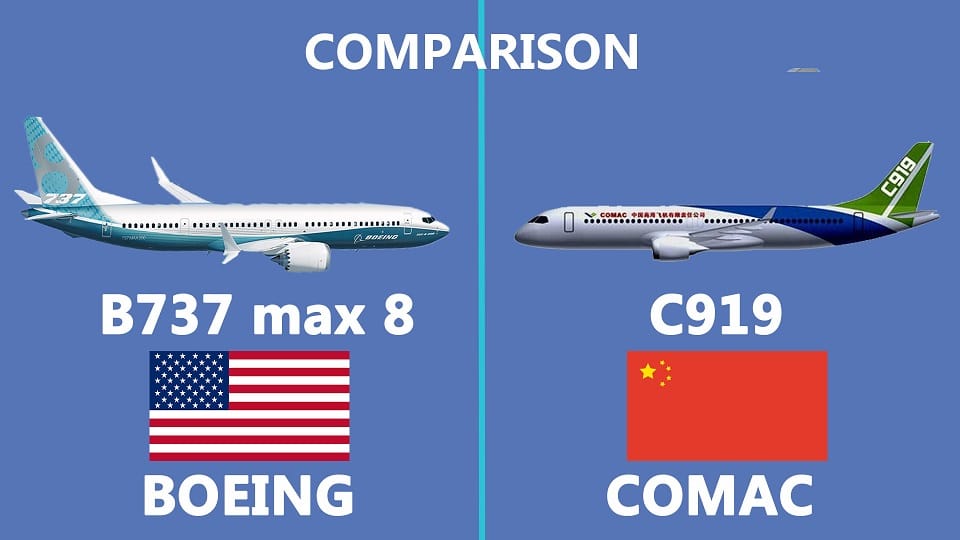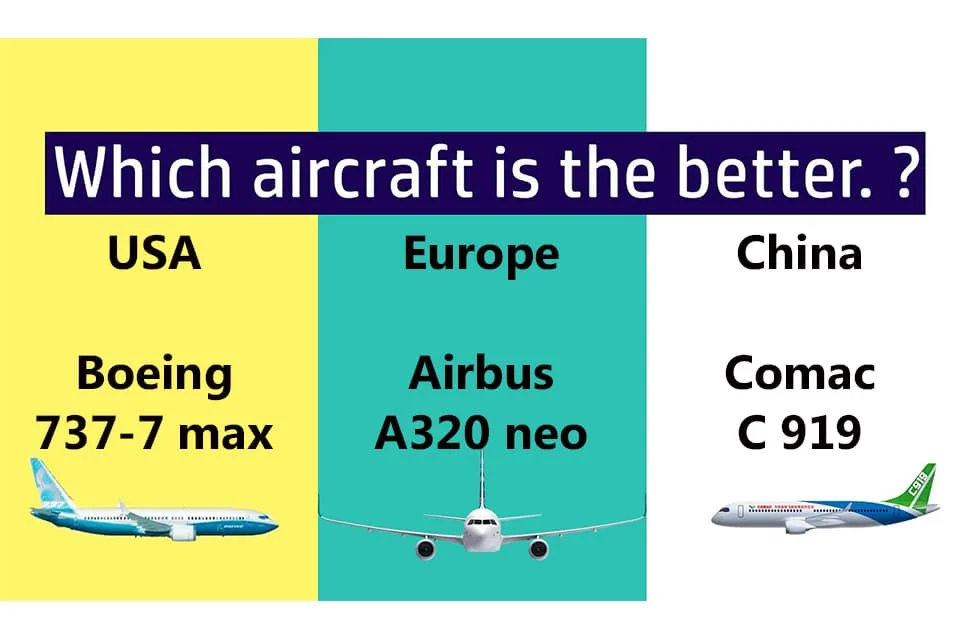Aircraft comparison
Aircraft comparisons between the Chinese-built comac C919 and the Boeing 737 max 8

In this post, we’ll compare two narrow-body aircraft, one from the United States (the Boeing 737 Max 8 aircraft) and one from China (the Comac C919 aircraft), which was just domestically manufactured.
China is seeking a larger market to supply its aircraft to domestic and foreign customers. Eastern China Airlines has recently received delivery of its first aircraft. With regard to its Boeing 737 segment of aircraft, Boeing already holds the largest market share. Undoubtedly, if the Comac aircraft becomes widely used, Boeing may lose market share in China.
Let’s analyze the specifications of both aircraft.
[adinserter block=”12″]
Boeing B737-8.
The Boeing 737 MAX is the fourth generation of the Boeing 737, a narrow-body airliner manufactured by Boeing Commercial Airplanes (BCA), a division of the American company Boeing. The first MAX 8 was delivered in May 2017 to Malindo Air, which began using it on May 22, 2017. A MAX 8 carrying 162 passengers on a 3,000 nautical mile (5,600 km) flight is anticipated to burn 1.8 percent less fuel than an airplane with blended winglets.
Compared to the A320neo, the MAX 8 is heavier at takeoff and has a lower empty weight. During a test flight for Aviation Week, the aircraft was flying at a less-than-ideal height while cruising at a real airspeed of 449 knots (832 km/h) and weighing 140,500 pounds (63,700 kg). The Boeing 737 MAX 8 completed its first flight test in La Paz, Bolivia. The 13,300-foot altitude at El Alto International Airport tested the MAX’s capability to take off and land at high altitudes.
[adinserter block=”13″]
In early 2017, a new B737-8 was valued at $52.85 million, rising to below $54.5 million by mid-2018, and the latest version is having a 200 Seater variant under construction for Ryanair. With a 160-passenger capacity, the 737-8 has so far been the most popular model.
Comac C919
A narrow-body airliner called the Comac C919 was created by the Chinese company Comac, and it had its inaugural flight on May 5, 2017. Not early than 2022 or 2023 is anticipated for the first commercial deliveries of the aircraft to China Eastern Airlines. Comac had 1008 pledges as of the end of August 2018, including 305 firm orders, many of which came from Chinese leasing companies or airlines.
At Shanghai Pudong International Airport, the C919 successfully completed its first pre-delivery flight test. According to Comac, the aircraft successfully finished a three-hour test session on May 14, 2022. This year will see the delivery of the aircraft in the livery of the Chinese company OTT Airlines, a division of China Eastern. The aircraft was listed in May 2022 for 653 million yuan (US$95 million), nearly matching the prices of the Airbus A320neo and Boeing 737 Max rivals and more than double the earlier estimate of US$50 million.
How the Comac C919 similar from the A320 and B737 Max.(Opens in a new browser tab)
The C919 has a lower maximum fuel capacity than the A320 and 737-800, As a result, the normal variant’s range is only 2,200 nm and the extended range variants is 3,000 nm, respectively. Because the C919 was built to accommodate more passengers than the Boeing 737-800 in a standard all-economy configuration, COMAC was able to expand the fuel capacity and, consequently, the range of the aircraft.
[adinserter block=”2″]
China certifies C919 jet to compete with Airbus and Boeing(Opens in a new browser tab)
Here are some of the differences between the Boeing 737-8 and the Comac C919:
- Manufacturing: The Boeing 737-8 is manufactured by Boeing, a US-based aerospace corporation, while the Commercial Aircraft Corporation of China (COMAC), a Chinese state-owned aircraft manufacturer, the Comac C919.
- History: The Boeing 737 is a well-known aircraft model that has been in service for almost 50 years, whereas the Comac C919 is a newer aircraft that is currently in development.
- Size: The Comac C919 is slightly smaller than the Boeing 737-8, with a seating capacity of up to 210 people compared to the 737-8’s 174 seats.
- Range: The Boeing 737-8 has a range of about 6,570 km (3,550 nmi), whereas the Comac C919 has a range of about 5,576 km (3,011 nmi)
- Engines: The Boeing 737-8 is powered by CFM International LEAP engines, while the Comac C919 is powered by CFM International LEAP-1C engines.
- Cost: The Comac C919 is generally considered to be less expensive than the Boeing 737-8, with a list price of approximately $95 million compared to the $99.7 million list price of the 737-8.
- Orders: The Boeing 737-8 has over 5,800 orders from airlines all over the world, while the Comac C919 has over 800 orders.
- Customers: The Boeing 737-8 is used by various airlines, including several major worldwide carriers, but the Comac C919 is mostly used by Chinese airlines.
- Certification: The Boeing 737-8 has been certified by aviation authorities worldwide, including the Federal Aviation Administration (FAA) in the United States and the European Aviation Safety Agency (EASA), while the Comac C919 is still in the certification process.
- Performance: The Boeing 737-8 has a proven track record of reliability and performance, but the Comac C919 is still in the midst of demonstrating its potential.
| Specifications | B737-8 | C919 |
| Length | 129 ft (39.47 m) | 127.6 ft (38.9 m) |
| Wingspan | 117 ft (35.92m) | 117.5 ft (35.8 m) |
| MTOW | 182,200 lb (82,600 kg) | 159,835 lb (72,500 kg) |
| Maximum Payload | 46,040 lb (20,880 kg) | 45,000 lb (20,400 kg) |
| Range | 3,550 nmi (6,570 km) | 2,200 nmi (4,075 km) |
| Cruise | Mach 0.79 (453 kn; 839 km/h) | Mach 0.785 (450 kn; 834 km/h) |
| Takeoff | 8,300 ft (2,500 m) | 6,600 ft (2,000 m) |
| Landing | 5,000 ft (1,500 m) | 5,200 ft (1,600 m) |
| height | 40 ft (12.29m) | 39.2 ft (11.95 m) |

Aircraft comparison
Comparison between Comac C919 and A320 aircraft

The COMAC C919 and the Airbus A320 represent two significant players in the narrow-body commercial aircraft market, each reflecting its manufacturer’s vision for the future of aviation.
The C919, developed by the Chinese aerospace manufacturer COMAC, aims to challenge established Western dominance with its advanced technology and cost-effective design. In contrast, the Airbus A320, a stalwart of global aviation for decades, continues to set benchmarks for efficiency, safety, and passenger comfort.
This comparison explores the key differences and similarities between these two aircraft, highlighting their design philosophies, performance metrics, and market implications.
How the Comac C919 similar from the A320 and B737 Max:Click here
The COMAC C919, predominantly built using aluminum alloys, is equipped with CFM International LEAP turbofan engines. It has the capacity to accommodate between 156 and 168 passengers in its standard configuration.
This twin-engine jet features a six-abreast economy cabin layout. Initially, it offered options for either CFM56 or IAE V2500 turbofan engines, though the CFM56/PW6000 combination was exclusively used for the A318 model. It can accommodate 195 passengers.
COMAC C919 vs. Airbus A320: A Comparative Overview
Length: The C919 measures 38.9 meters (127.6 feet) in length, slightly longer than the A320, which is 37.57 meters (123 feet 3 inches) long. This extra length provides a marginally larger cabin for the C919.
Wingspan: Both aircraft share the same wingspan of 35.8 meters (117.5 feet), indicating similar aerodynamic properties and potential for comparable fuel efficiency and performance.
Height: The C919 stands at 11.95 meters (39.2 feet) in height, surpassing the A320’s height of 11.76 meters (38 feet 7 inches). This difference is relatively minor but may impact cabin space and cargo hold configuration.
Aircraft comparisons between the comac C919 and B737 max 8:Click here
Weight: The COMAC C919 has a maximum takeoff weight of 42,100 kilograms (92,815 pounds), slightly less than the A320’s 42.6 tonnes (93,900 pounds). The A320’s marginally higher weight suggests it may be able to handle slightly more payload or fuel.
Range: The C919 offers a range of 4,630 kilometers (2,500 nautical miles), which is shorter compared to the A320’s range of 6,112 kilometers (3,300 nautical miles). This extended range of the A320 makes it better suited for longer routes and provides airlines with more operational flexibility.
Nearly twice as much as the $50 million that analysts predicted, comac c919 price is roughly $91 million. That is comparable to the cost of the Boeing 737-800 and the Airbus A320neo, which, as of 2021, are estimated to be $106 million and $111 million, respectively.
-

 Travel1 week ago
Travel1 week agoAir India to Expand US Operations with Three New Routes After a Decade
-

 Travel2 weeks ago
Travel2 weeks agoWhy We Should Avoid These Stamps in a Passport
-

 Airlines1 month ago
Airlines1 month agoInvestigations Reveal Fake Chinese Titanium in Boeing and Airbus Jets
-

 Tech4 weeks ago
Tech4 weeks agoChina’s CATL Plans 1,800-Mile Electric Plane Launch by 2027
-

 Airport3 days ago
Airport3 days agoTop 10 Largest Airports in the World by Size
-

 Aerospace4 weeks ago
Aerospace4 weeks agoChina’s Fighter Jets Turn Wings into Autonomous Drones
-

 Airlines4 days ago
Airlines4 days agoAir India Rolls Out A350s for Delhi-New York JFK and Newark Routes
-

 Defence3 weeks ago
Defence3 weeks agoBoeing Enhances Chinook with New Engines and Block II Upgrades at $96 Million







